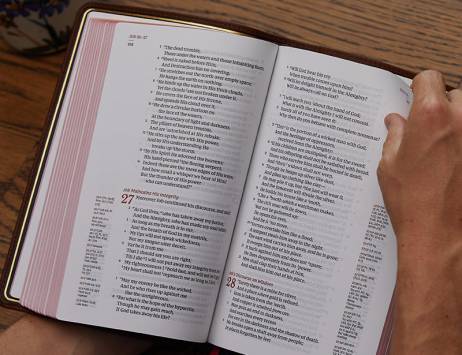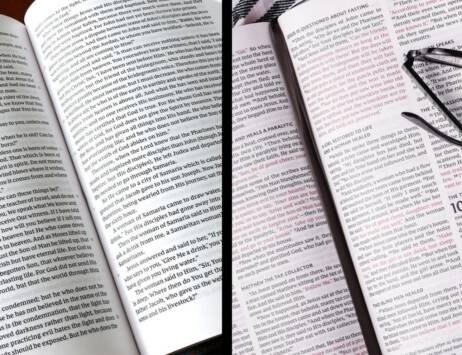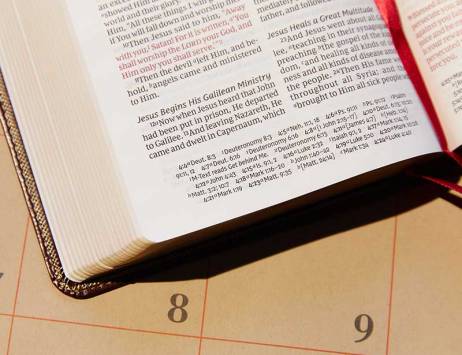Two of the most popular types of Bible designs we see today are text-only and reference editions. Both are designed for a specific purpose and have advantages and disadvantages. This can make it difficult to know which type of Bible you need.
In this article, we’ll discuss what these two types of Bibles are and see the advantages and disadvantages of both to help you decide which is best for your needs.
What is Text-Only?
A text-only Bible is an edition without cross-references. They often include section headings to help the reader identify topics and transitions of thought. Those without section headings in the text often have summaries at the top of the page. Many include footnotes by the translators. They sometimes include tools in the back, such as a concordance or maps, but not always.
Unlike a Reader’s edition, which removes chapter and verse numbers to focus on reading, text-only Bibles include chapter and verse numbers to help you locate Scriptures quickly.
Advantages of Text-Only Bibles
Text-only Bibles have fewer distractions in and around the text, allowing for smoother reading, preaching, and teaching.
The page doesn’t have to be designed to accommodate a referencing system. This means more of the biblical text can be placed on the page, creating a Bible with fewer pages. Alternately, the Bible can have a larger print for the same size Bible as a reference edition.
Disadvantages of Text-Only Bibles
Text-only Bibles don’t include a lot of tools. Using them requires external resources for study.
Without references, they’re not ideal as an all-purpose Bible.
What is a Reference Bible?
A reference Bible is one that has cross-references on the page with the biblical text to help the reader locate passages of the same or related themes, see where something was quoted from or alluded to, etc. They help the reader find more information and see how the Scriptures are interconnected.
Cross-references are placed in various locations depending on the design of the page. Popular layouts include the references between two columns of text, in the outer margin, in the inner margin, at the end of verses, across the bottom of the page, or below the text in one of the two columns.
Reference editions usually include the translation footnotes. They can be placed with the cross-references or in a separate location on the page.
Reference Bibles often include other tools such as a concordance and maps. They sometimes include short book introductions. They differ from Study Bibles in that they don’t include commentary, articles, or other study material.
Advantages of Reference Bibles
Reference Bibles have good basic tools, making them a good choice for general use. You can do a basic study or find basic information without having to use external resources.
References are at your fingertips, so you don’t have to get other books off the shelf or carry them with you.
External resources are not required, so fewer books are needed. This reduces the number of books you need to buy for your library.
Each of the layouts works well for specific purposes. For example:
- References that are placed in a column are easier to locate quickly.
- Those at the end of verses have fewer cross-references but make the best use of space and include the most important references.
- Those at the bottom of the page take a few seconds to locate, but the text isn’t made more narrow to allow a references to fit.
Disadvantages of Reference Bibles
Reference Bibles are limited in the number of references they can provide. They can’t include every possible reference. You’ll still want to use other materials and read the Scriptures to see more connections.
The text has letters next to words that connect a portion of the text to a reference. These letters can be distracting while reading.
When following references, you’ll need to keep your place and go back to it to get the next verse. Fortunately, having extra ribbons such as those in the Premier Collection or other editions in the Comfort Print line helps to keep your place.
Choosing Between a Text-Only and Reference Bible
Both types of Bibles have their strengths and weaknesses and are better at serving the purpose they were designed for. With this in mind, we recommend using both types.
However, when choosing one consider the following…
Choose a text-only Bible if:
- You already have study tools and you don’t mind using separate tools for study.
- You want a larger print in a smaller Bible.
- A cleaner text for reading is your preference.
- You rarely use the references in a Bible.
- You don’t plan to use the tools in the Bible and don’t want to carry around tools that you’re not using.
Example use-cases include:
- Reading with fewer distractions
- Preaching or teaching with fewer distractions
- Studying from the clean text while using external tools
- Carrying a smaller Bible without sacrificing the text size
Choose a reference Bible if:
- You want to have quick access to a cross-reference system.
- The extra space the references take up on the page isn’t an issue for you.
- You need one Bible to carry and study from without having to carry other resources, but you don’t need a study Bible.
Example use-cases include:
- Personal study
- Small group study
- Sermon prep
- Completing assignments for classes
- Carrying one Bible without losing important tools
Conclusion
Text-only and reference Bibles are great choices for reading and studying Scripture. There is no one perfect design for every purpose. Which you need depends on how you plan to use it. With this in mind, we recommend that purchase both styles if possible to take advantage of what both have to offer.
To find the perfect Bible for your needs, take a look at the Thomas Nelson shop.






2 replies on “Text Only vs Reference Bibles – When to Use Them”
Which Bible is the closest to the original for translation purpose
Well I have two reference bibles and I had considered using a study Bible due to the danger of other people’s opinions. I had wondered due to the many denominations and cultures in which these differences can come about; the wonder of the comment made by Jesus man shall not live by bread alone but by every word, that proceed from the mouth of God. How much of the different denominations in their perspective is the Word of God to them in obedience? How much of identification do we think to be in alignment to the original twelve disciples? Is the original teaching of Jesus is it in alignment of what is called Christianity?